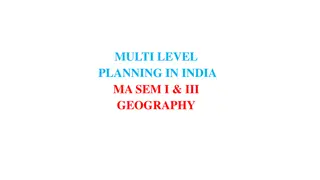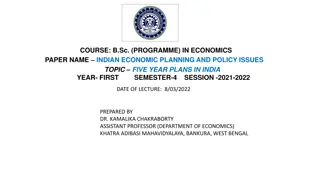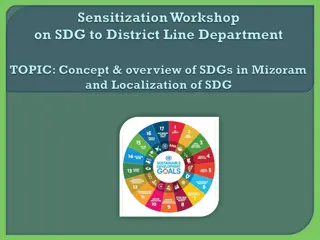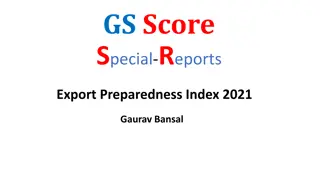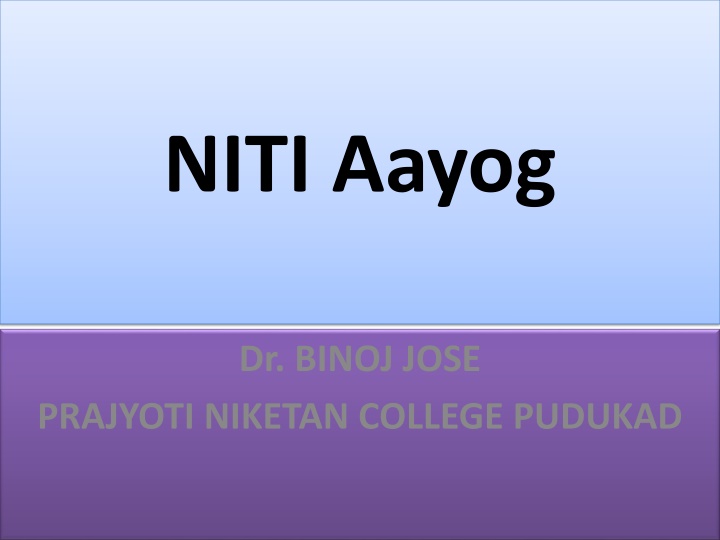
NITI Aayog: Transforming India's Policy Landscape
Learn about NITI Aayog, the institution established by the NDA Government in 2015 to replace the Planning Commission. Discover its objectives, history, and evolution, as well as its role in fostering cooperative federalism and supporting socio-economic development in India.
Download Presentation

Please find below an Image/Link to download the presentation.
The content on the website is provided AS IS for your information and personal use only. It may not be sold, licensed, or shared on other websites without obtaining consent from the author. If you encounter any issues during the download, it is possible that the publisher has removed the file from their server.
You are allowed to download the files provided on this website for personal or commercial use, subject to the condition that they are used lawfully. All files are the property of their respective owners.
The content on the website is provided AS IS for your information and personal use only. It may not be sold, licensed, or shared on other websites without obtaining consent from the author.
E N D
Presentation Transcript
NITI Aayog Dr. BINOJ JOSE PRAJYOTI NIKETAN COLLEGE PUDUKAD
INTRODUCTION NITI Aayog (National Institution for Transforming India) is an extra- constitutional institution created by the NDA Government in 2015. NITI Aayog replaced the 65 years old planning commission and its legacies. There were very vehement criticisms against planning commission, especially against its relevance and utility. Perhaps, the shift in the political leadership of the country could be another factor for replacing Planning Commission and constituting NITI Aayog. NITI Aayog is expected to rejuvenate the planning process and provide effective response to socio- economic needs of the country. The National Institution for Transforming India, also called NITI Aayog is the premier policy Think Tank of the Government of India, providing both directional and policy inputs. While designing strategic and long term policies and programmes for the Government of India, NITI Aayog also provides relevant technical advice to the Central and State Governments. It aims to construct a strong state that will help to create a dynamic and strong nation. This helps India to emerge as a major economy in the world. The NITI Aayog s creation has two hubs called Team India Hub , which leads the participation of Indian states with the central government and Knowledge and Innovation Hub , which builds institution s think tank capabilities.
History and Evolution The NITI Aayog came into being on January 1, 2015. The planning commission was the predecessor commission was constituted in march1950. It was an extra- constitutional body and an arm of the central government introduced immediately after the independence. commission India formulated many five year plans. It made an assessment in the material, capital and human resources of India, including technical personnel, and investigate the possibilities of augmenting those are related resources which are found to be deficient in relation to the nation's requirement. It also formulated a plan for the most effective and balanced utilisation of country's resources.Most of the five year plans emphasized on developing the public sector. However, the relevance and utility of the planning commission was a debated issue for long. Many viewed that the planning commission failed in providing the country with rational and pragmatic plans for the soci-economic development. Under this context, especially as the political leadership of the nation got changed, the planning commission was replaced with NITI Aayog. NITI Aayog, was formed via a resolution of the Union Cabinet on January 1, 2015. of NITI Aayog. Plannin Under the planning
OBJECTIVES The active participation of States in the light of national objectives and to provide a framework national agenda . To promote cooperative federalism through well-ordered support initiatives and mechanisms with the States on an uninterrupted basis. To construct methods to formulate a reliable strategy at the village level and aggregate these gradually at higher levels of government. Economic policy that incorporates national security interests. To pay special consideration to the sections of the society that may be at risk of not profiting satisfactorily from economic progress. To propose strategic and long-term policy and programme frameworks and initiatives, and review their progress and their effectiveness. To grant advice and encourage partnerships between important stakeholders and national- international Think Tanks, as well as educational and policy research institutions.
OBJECTIVES To generate a knowledge, innovation and entrepreneurial support system through a shared community of national and international experts, etc. To provide a platform for resolution of inter-sectoral and inter- departmental issues in order to speed up the accomplishment of the progress agenda. To preserve a state-of-the-art Resource Centre, be a repository of research on good governance and best practices in sustainable and equitable development as well as help their distribution to participants. To effectively screen and assess the implementation of programmes and initiatives, including the identification of the needed resources to strengthen the likelihood of success. To pay attention to technology improvement and capacity building for the discharge of programs and initiatives. To undertake other necessary activities in order to the implementation of the national development agenda, and the objectives.
COMPOSITION CHAIRPERSON GOVERNING COUNCIL REGIONAL COUNCIL VICE CHAIRPERSON FULL TIME MEMBERS PART TIME MEMBERS SPECIAL INVITEES EX-OFFICIO MEMBERS CHIEF EXECUTIVE OFFICER
COMPOSITION Prime Minister of India is the Chairperson Governing Council consists of the Chief Ministers of all the States and Lt. Governors of Union Territories in India. Regional Councils will be created to address particular issues and possibilities affecting more than one state. These will be formed for a fixed term. It will be summoned by the Prime Minister. It will consist of the Chief Ministers of States and Lt. Governors of Union Territories. These will be chaired by the Chairperson of the NITI Aayog or his nominee. Himalayan States Regional Council is an example Special invitees: Eminent experts, specialists with relevant domain knowledge, which will be nominated by the Prime Minister. The full-time organizational framework will include, in addition to the Prime Minister as the Chairperson: Vice-Chairperson (appointed by the Prime Minister) Full-time Members Part-time members: Maximum of 2 members from foremost universities, leading research organizations and other innovative organizations in an ex-officio capacity. Part- time members will be on a rotational basis. Ex Officio members: Maximum of 4 members of the Council of Ministers which is to be nominated by the Prime Minister. Chief Executive Officer: CEO will be appointed by the Prime Minister for a fixed tenure. He will be in the rank of Secretary to the Government of India.
INITIATIVES Its initiatives include "15-year road map", "7-year vision, strategy, and action plan", AMRUT, Digital India, Atal Innovation Mission, Medical Education Reform, Agriculture reforms (Model Land Leasing Law, Reforms of the Agricultural Produce Marketing Committee Act, Agricultural Marketing and Farmer Friendly Reforms Index for ranking states) Indices Measuring States Performance in Health, Education and Water Management. Sub-Group of Chief Ministers on Rationalization of Centrally Sponsored Schemes, Sub-Group of Chief Ministers on Swachh Bharat Abhiyan, Sub- Group of Chief Ministers on Skill Development. Task Forces on Agriculture and iradicating Poverty, Transforming India Lecture Series. Himalayan States regional council and South Asian Regional Conference on Urban Infrastructure etc. Sustainable Action for Transforming transformation of two social sectors- Education and Health EK Bharath Shreshtha Bharath- Unity through cultural exchange Human capital (SATH)-
PLANNING COMMISSION vs. NITI Aayog Planning Commission NITI Aayog Came into being on 1 January 2015 Bottom-up approach Cooperative federalism Short and very long term Plans and policies Initiative by BJP Only an advisory body or think tank- no such powers Provision for part time members Came into being on 15 March 1950 Top-bottom approach Centralized Five year plans Initiative by Congress Had the power to allocate fund No provision for part Time members
CRITICISMS Some scholars regard the introduction of NITI Aayog as political necessity occurred due to shift in the political leadership. It cannot transform an unequal society into a fair modern economy which can ensure the welfare of all its citizens, regardless of their caste, creed or economic identity. It cannot influence either public or private investments as it presently enjoys no influence in policymaking decisions or consequences, like the rolling out of demonetisation and Goods and Services Tax (GST). The independence and autonomy of NITI Aayog is questioned. It is the premier think tank of the nation supposed to generate new ideas. However, it acts as an agency to praise the policies and programmes of the government.
CONCLUSION As part of its reform agenda, the Government of India constituted the NITI Aayog, replacing the Planning Commission which was instituted in 1950. This was done in order to better serve the needs and aspirations of the people of India. An important evolutionary change from the past, NITI Aayog acts as the quintessential platform of the Government of India to bring States to act together in national interest, and thereby fosters Cooperative Federalism. NITI Aayog is a center of resources, knowledge, and skills that will help the government to act with speed, frame effective policies and manage unforeseen issues. NITI Aayog is a inevitable institutional changes in administration and policy framing that could seed and foster substantial scale of change in the development of the country.
THANK YOU Dr. BINOJ JOSE ASSISTANT PROFESSOR IN POLITICAL SCIENCE PRAJYOTI NIKETAN COLLEGE PUDUKAD

